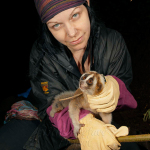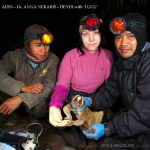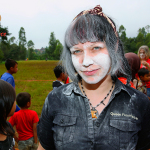By Anna Nekaris
My journey to study Asia’s lorises began in 1993 at a conference at Duke University’s Primate Centre (now the Duke Lemur Centre). The conference, aptly entitled Creatures of the Dark – the Nocturnal Prosimian, was attended by some of prosimiology’s greatest names – Pierre Charle-Dominique, Simon Bearder, Patricia Wright, Robin Crompton, Yves Rumpler and many others. Still, only a few talks represented a major branch of the nocturnal primates – the lorises. Helga Schulze presented her beautiful drawings of captive slender lorises – a now famous ethogram. And Lon Alterman – large to the amusement of the crowd – presented the first behavioural study of slow loris venom – a trait we know now is a fascinating biological fact, and although very rare in mammals, is no cause for amusement!
I realised that a huge gap existed in our knowledge of the world’s primates, and my the first leg of my journey led me to PhD research in India. With renowned primatologist Mewa Singh as my mentor, we combed South India’s forests for slender lorises with only a tiny handful of sightings. In those days, when beautifully written letters ruled our communication sphere, I had only been back at my university at Washington University St Louis, for a matter of weeks when Prof Singh wrote to me excitedly in his boyish hand – we found slender lorises! You can see them everywhere, on fences, on roads, calling from the top of the tea shop…and my PhD was in order.
We discovered that slender lorises were highly insectivorous – in a whole year 97% of their diet was insects – 100s per night gobbled up like crunchy popcorn. They were super social, following each other nose to bum as they clambered noiselessly -yes they can do that – into their social sleep sites. And they were so fast with these tiny banana-sized primates sharing home ranges the size of three football fields.
The journey then took me to Sri Lanka where I wanted to see the ‘other slender lorises’ and found a whole new species – the tiny and adorable red slender lorises that clings to Sri Lanka’s tiny rainforest patches. This led to my first radio-tracking study of a loris species – with these even tinier primates moving even faster (they can race walk!) and having even huger home ranges!
All the while, I received small messages – since internet and email still were not popular – that the slow lorises all over the rest of Asia were in extreme threat. Could I Help? Could I come to this country or that? `I finally in 2006 headed to Java, then later to Singapore, in 2007 to Sumatra, in 2008 to Cambodia, in 2009 to Thailand, not to mention visits to China, Vietnam and NE India, to see the plight of the loris first-hand. I wondered how no one had taken up their plight? A few organisations had a loris on their list of the many species they might help – but they were being annihilated…..then IT happened.
In 2009, Sonya hit our screens -that loveable Russian-dwelling loris, seen by millions being tickled in a brightly lit room. The world suddenly loved the loris – but for all the wrong reasons – the problem that had struck Asia for so many years had become global – just about everyone seemed to want a loris as a pet.
Thus the Little Fireface Project was born – and all the news you can continue to read here, on our Facebook page, via our Twitter posts, our YouTube channel and our newsletter – not to mention our scientific publications, government documents and action plans.
I want to take this moment – the last day of SLOW week – to thank our wonderful supporters who have funded this vital work – you cannot imagine how much our hearts go out to you for deigning to support the lorises – so often known as brown unimportant nocturnal creatures. I want to thank all the wonderful volunteers who drew us logos, lorises, picture books, helped with web design, donated photographs, items for sale, had carboots, yoga classes and weddings for the lorises! And those who just donated their time! Every second is valued by us! I would like to thank those who bought a shop items and wore it around -perpetuating the message that lorises are not pets! And those who adopted a loris that allowed us to to do vital work like responding to emergencies for former pets who needed rescuing. And I want to thank all of you who support us on the social networks – every click – every share – honestly and truly – can help save these beautiful wonder little firefaces – should that fire go out the world will really be a darker place.



